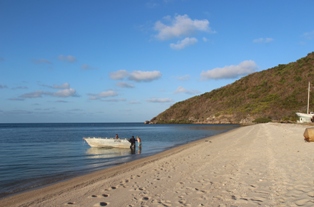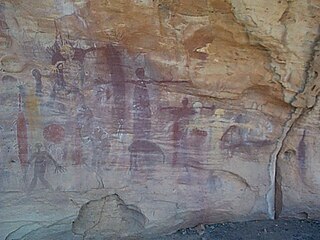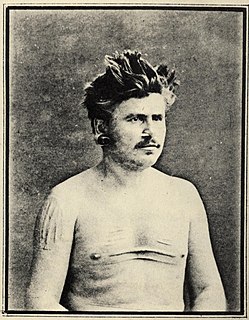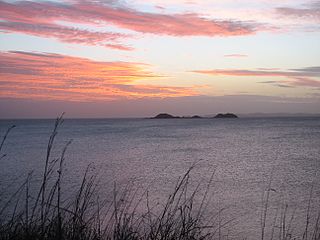
The Jardine River National Park is a national park in Queensland, Australia, 2,137 km (1,328 mi) northwest of Brisbane and about 900 km (559 mi) northwest of Cairns, on the tip of Cape York Peninsula.

Maʼalpiku Island National Park, or Restoration Island, is a national park at Iron Range in the Shire of Cook in Far North Queensland, Australia, 1928 km northwest of Brisbane and a few hundred metres (yards) from Cape Weymouth and the Iron Range National Park. The park includes part of Restoration Island and nearby Restoration Rock.

Cape York Peninsula is a large peninsula located in Far North Queensland, Australia. It is the largest unspoiled wilderness in northern Australia. The land is mostly flat and about half of the area is used for grazing cattle. The relatively undisturbed eucalyptus-wooded savannahs, tropical rainforests and other types of habitat are now recognised and preserved for their global environmental significance. Although much of the peninsula remains pristine, with a diverse repertoire of endemic flora and fauna, some of its wildlife may be threatened by industry and overgrazing as well as introduced species and weeds.

Laura is a rural town and locality in the Shire of Cook, Queensland, Australia. In the 2016 census the locality of Laura had a population of 228 people.

Coen is a town and coastal locality in the Shire of Cook, Queensland, Australia. The town of Coen is inland on the Peninsula Developmental Road, the main road on the Cape York Peninsula in far northern Queensland. In the 2016 census, Coen had a population of 364 people.

Lockhart River is a town in the Aboriginal Shire of Lockhart River and a coastal locality split between the Aboriginal Shire of Lockhart River and the Shire of Cook, on the Cape York Peninsula in Queensland, Australia. In the 2016 census, Lockhart River had a population of 724 people.
Mitirinchi (Quoin) Island is a national park in the Great Barrier Reef Marine Park Queensland, Australia, 1,947 km (1,210 mi) northwest of Brisbane. It is situated about 30 km (19 mi) north-east of Iron Range National Park and Lockhart River in the Cape Weymouth area near Portland Roads.

The Shire of Cook is a local government area in Far North Queensland, Australia. The Shire covers most of the eastern and central parts of Cape York Peninsula, the most northerly section of the Australian mainland.

Cape Grenville, is a small, east-facing promontory along the Queensland, Australia coast of Cape York Peninsula. It lies between Shelburne Bay to the north and Temple Bay to the south. The nearest significant settlement is Weipa, along the western coast of Cape York.

Roger Llewellyn Dunmore Cribb was an Australian archaeologist and anthropologist who specialised in documenting and modelling spatial patterns and social organisation of nomadic peoples. He is noted for conducting early fieldwork amongst the nomadic pastoralists of Anatolia, Turkey; writing a book on the archaeology of these nomads; pioneering Australian archaeology and anthropologies' use of geographical information systems, plus genealogical software; and conducting later fieldwork documenting the cultural landscapes of the Aboriginal peoples of Cape York Peninsula.
Umpila is an Aboriginal Australian language, or dialect cluster, of the Cape York Peninsula in northern Queensland. It is spoken by about 100 Aboriginal people, many of them elderly.

Quinkan rock art refers to a large body of locally, nationally and internationally significant Aboriginal rock art in Australia of a style characterised by their unique representations of "Quinkans", found among the sandstone escarpments around the small town of Laura, Queensland. Quinkan Country was inscribed on the Australian National Heritage List on 10 November 2018.
The Olive River is a river located in the Cape York Peninsula of Far North Queensland, Australia.
The Pascoe River is a river located in Far North Queensland, Australia.
The Pakadji people, also known by the southern tribal exonym as the Koko Yao, are an Aboriginal Australian group of Cape York Peninsula in northern Queensland. The ethnonym Koko Yaʼo is said literally to mean " talk, speech" (koko/kuku) 'this way' (yaʼo), though this has been questioned.

The Uutaalnganu people, also known as Night Island Kawadji, are an Aboriginal Australian group of Cape York Peninsula in northern Queensland. The name is also used collectively for several peoples in this area, such as the Pontunj / Jangkonj (Yanganyu), whose language is unconfirmed.
The Umpila people are an Aboriginal Australian people of the eastern Cape York Peninsula in northern Queensland. The majority of the remnant of the Umpila now live in Lockhart.
The Umpithamu, also once known to ethnographers as the Koko Ompindamo, are a contemporary Aboriginal Australian people of the eastern Cape York Peninsula in northern Queensland. Norman Tindale, transcribing their ethnonym Umpithamu as Umbindhamu, referred to them as a horde of the Barungguan.
The Pontunj, also called the Yankonyu, are a contemporary Indigenous Australian people of the eastern Cape York Peninsula in northern Queensland.

Umagico is a town and coastal locality in the Northern Peninsula Area Region, Queensland, Australia. In the 2016 census, Umagico had a population of 427 people.











